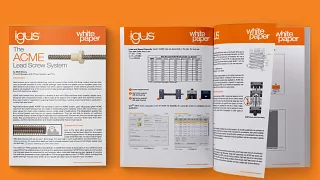Change Language :

Enhance Your ACME Lead Screw Experience with dryspin®
We're thrilled to announce significant advancements designed to expand our ACME lead screw offerings and enhance your configuration experience. We are substantially increasing our ACME lead screw inventory, tooling up production for 22 different sizes. This more than doubles our current selection, providing you with greater flexibility to find the perfect fit for your specific application requirements.
Browse the Shop and Configure a Custom Solution

White Paper: The ACME Lead Screw System
One of the most common lead screw geometries in North American manufacturing is the ACME lead screw system. Designed with a trapezoidal shape, a flank angle of 29 degrees and a higher pitch than fastening screws, ACME lead screws were made for applications requiring frequent positioning, including power transmission applications moving high axial loads. High-performance plastic ACME nuts are also ideal to use in an ACME system.
Learn about the benefits of an ACME lead screw system, relevant applications and industries, and ACME lead screw geometry in this white paper.
FAQ: Frequently Asked Questions
A: An ACME lead screw is a lead screw designed around imperial dimensions that is commonly used to convert the rotary motion of a motor, or hand wheel, into linear motion. They are typically used to drive linear bearings.
A: igus offers single-start ACME screws. This means there is one continuous thread that runs the entire length of the screw.
A: While almost identical there are minor differences. The main difference is that ACME screws are designed around imperial dimensions, whereas Trapezoidal screws are metric. The thread flank angles are also slightly different: ACME screws have a 29-degree angle while Trapezoidal screws are 30-degrees. These two types of screws can be used for the same applications, the primary difference being the designer's preference on units of measure.
A: ACME screws are made with a single-start whereas high helix are composed of multiple starts with higher lead angles. As a result, high helix screws are able to move at higher linear feed rates and lower RPMs than a single start screw. Conversely, the single-start screws are able to move higher loads with less torque. This higher efficiency also means that high helix screws can backdrive, where ACME screws are self-locking — each has its own advantage depending on the application, but a brake mechanism may be required on high-helix setups, particularly in vertical orientations.
A: 304 stainless steel is the material igus offers as standard. Carbon screws are available but may corrode without oil or grease, and igus lead screw nuts are designed to run without external lubrication.
A: Yes, local manufacturing of ACME screws significantly reduces lead times by cutting out overseas shipping and delays. As we continue to expand our range of ACME products manufactured in the USA, we will have the capacity to stock more lead screws and the flexibility to manufacture parts that are out of stock on shorter notice. Overall, lead times will be shorter and more reliable.
A: Local manufacturing helps stabilize ACME lead screw pricing by reducing reliance on global supply chain fluctuations. This stability will allow our ACME lead screws to remain among the most competitively priced stainless steel lead screws on the market today!
A: Our ACME parts are available in a variety of self-lubricating polymers, each with embedded solid lubricants to eliminate both the need for external lubrication and regular maintenance.
A: ACME screws are stocked standard in 6 foot (1829mm) lengths. Lengths up to 12 feet may be possible.
A: igus offers machining capabilities to include journals, wrench (spanner) flats into ACME screws. We offer bar stock materials as well as SLS printing services for custom nuts. We also offer several injection molding processes for both high and low quantities depending on the customer’s needs.
A: Yes, custom lead screws can be manufactured in the USA for faster turnaround and greater design flexibility. In addition to manufacturing ACME lead screws in the USA, we will also be localizing our machining of custom lead screws. This new addition will allow all of your custom journals, keyways, and threaded ends to be manufactured in our facility in Rumford RI, providing more reliable lead times and competitive pricing.
A: Due to the customization capabilities manufacturers like igus offer, ACME lead screws come in almost all of the most commonly used dimensions. igus currently offers ACME screws in 10 different dimensions, but we will be more than doubling our ACME screw selection. These new dimensions include: 3/16-50, 3/8-12, 3/4-8, 3/4-16, 1/4-20, 3/8-8, 3/8-16, 1/2-8, 1-4, 1-6, 1-8, 5/8-10. In addition to the hundreds of lead screw offerings we currently have, we are excited to continue to grow our selection. If we do not offer the dimension you are looking for, let us know and get sent an ACME lead screw on us! Just fill out this survey!
A: Our ACME nuts are available in a variety of self-lubricating polymers, each with embedded solid lubricants to eliminate both the need for external lubrication and regular maintenance.
A: igus offers ACME 2C, which is referred to as a "centralizing" with a lead accuracy of 0.0007" per every 1" of length. This is the optimal thread class for most power transmission applications. Please note that since the lead screw nuts themselves are plastic, there is no classification other than the clearance being optimized for the temperature range of the material to avoid binding.
Contact Us
Questions or product information? Please contact:

Customer Service
Customer Service:
Phone: Monday to Friday from 8 am - 8 pm
LiveChat: 24 hours
Book a Call
Book an Appointment with a Product Expert


